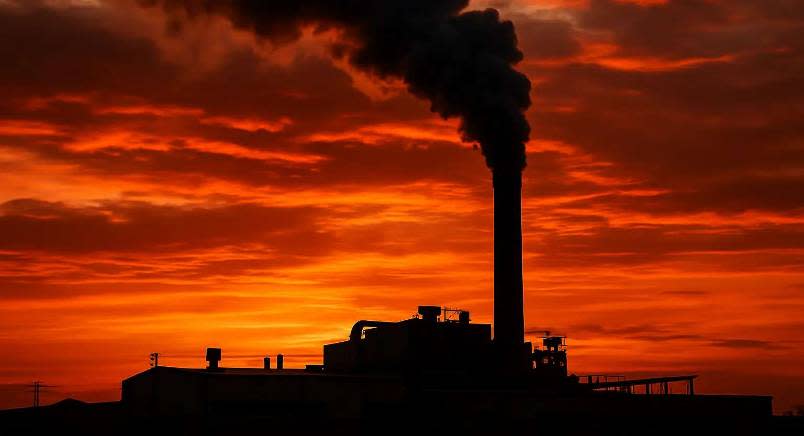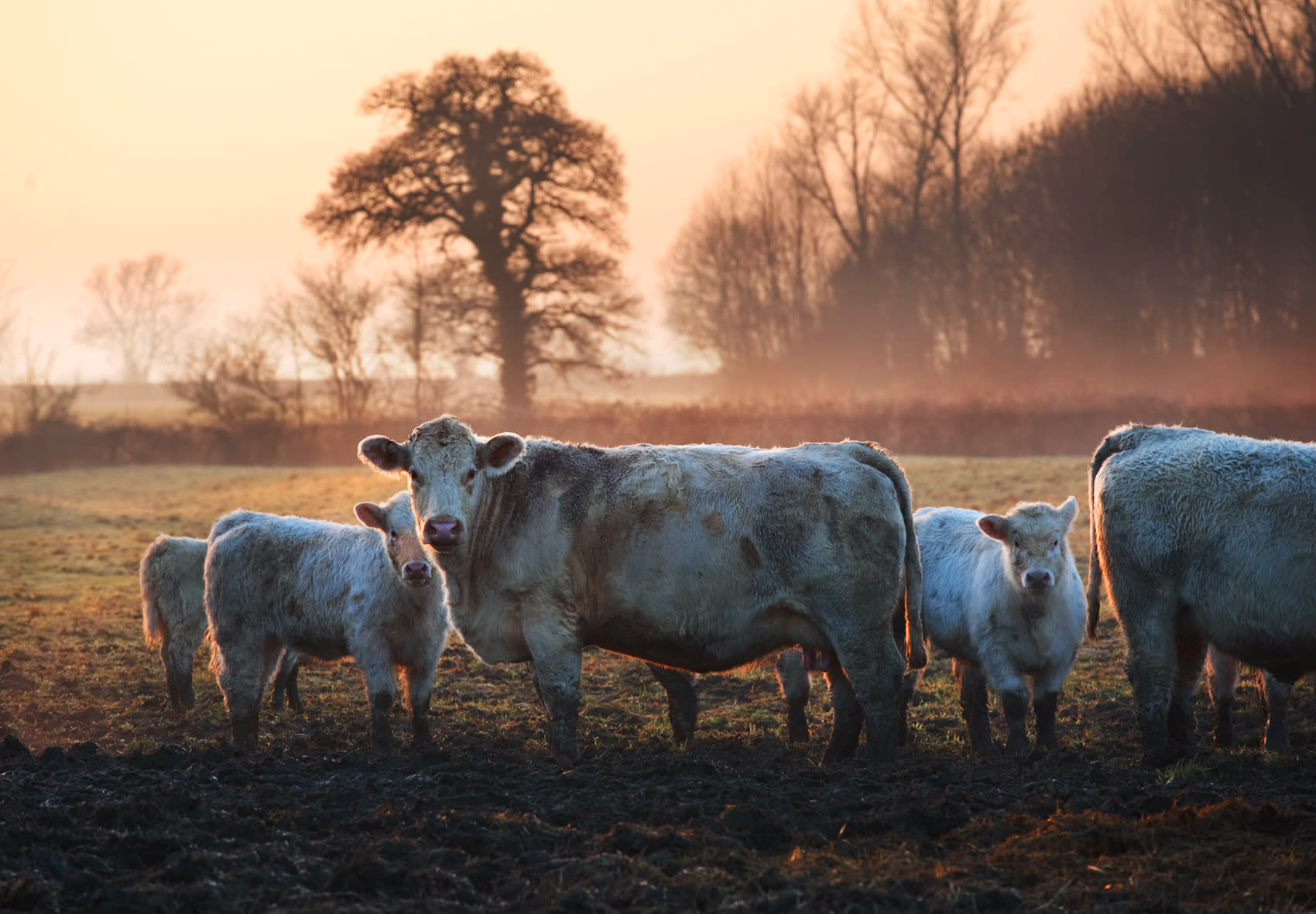




The beef industry tauts the idea of “regenerative ranching”—grazing cattle on degraded soils—as the answer to animal agriculture’s sustainability problem. However, is this practice really better for the environment?

Cows—and the people who farm them—are in the midst of a public relations crisis. At this point, it's practically common knowledge that the way we farm animals is a huge factor in the climate disaster facing our planet.
41% of global deforestation—and 80% of Amazon deforestation—is driven entirely by beef production. The beef industry is also the number one source of methane, a greenhouse gas 28 times more potent than carbon dioxide in warming the earth's atmosphere. When combined with other greenhouse gasses emitted by factory farming, livestock on a global scale emit 14.5% of all greenhouse gasses, half of which come directly from cows. All of these facts point to the beef industry as one of the biggest villains in the fight against climate change.
So, to the beef industry, the idea of "regenerative ranching" appeared like a ray of light over the horizon. Also called holistic rangeland management, rotational foraging and adaptive multi-paddock (AMP) grazing, amongst other labels, regenerative ranching argues that while cows and other livestock emit greenhouse gasses, putting cows on the move prevents overgrazing and reduces carbon dioxide emissions through soil carbon sequestration. The idea is that soil carbon sinks would soak up excess atmospheric carbon, offsetting the methane and other greenhouse gas emissions that arise from farming animals. Think of it as a carbon offset buried in the ground. Cows themselves play a role by trampling down weeds, adding organic matter to the soil and exposing it to more oxygen, helping create healthy land capable of soaking up more carbon.
A quick search finds dozens of articles, documentaries and even pieces of policy celebrating regenerative ranching as the savior for both our environment and our hamburgers. These stories all tend to start the same way, with a joyride around a happy and environmentally-friendly ranch. Blankets are offered, grassland is admired, cattle dogs wag their tails. Hardworking ranchers speak frankly about their exhausting work life. But it's all worth it! Look at these cows! Believe it or not, they're saving the planet.
But should we believe it?
Sustainability and scale: The myths behind regenerative ranching
Does regenerative ranching actually work? Unfortunately, the answer is more straightforward than regenerative ranching itself: No.
Multiple scientific studies find that regenerative ranching has severe sustainability and scale issues. In 2017, Dr Tara Garnett of the Food Climate Research Network at the University of Oxford led a team of international experts in an exhaustive report on the subject and found that "grass-fed livestock are not a climate solution." In her key takeaways, Dr. Garnett concluded, "Rising animal production and consumption, whatever the farming system and animal type, is causing damaging greenhouse gas release and contributing to changes in land use."
Regenerative ranching simply does not have the capacity to offset the massive greenhouse gas emissions that ranching—regenerative or not—causes. The Intergovernmental Panel on Climate Change estimated that agricultural soils globally could, at best, only sequester a few gigatons of carbon per year, nowhere near enough to work as an offset. Dr. Garnett and her team discovered that any contribution of grazing cows to soil carbon sequestration would be "small, time-limited, reversible and substantially outweighed by the greenhouse gas emissions they generate." Another study by the World Resources Institute found that practices grouped as regenerative agriculture—including not just regenerative ranching but also cover crops and no-till—could "improve soil health and yield some valuable environmental benefits... [but they] are unlikely to achieve large-scale emissions reductions."
Regenerative ranching's claims do not sufficiently address the scientific and practical challenges they face. The World Resource Institute (WRI) cites one pro-regenerative ranching paper which estimated that agricultural soils could draw down a trillion tons of carbon dioxide. But this is an amount greater than the entire amount of soil carbon lost since the dawn of agriculture! "Based on current evidence," the WRI concludes, "these levels of emissions-reduction potential aren't plausible."
Collateral damage from regenerative ranching
Nor is regenerative ranching a harmless technique in itself. Much of the theory behind it rests upon the idea of repurposing "marginal lands" to support cows grazing across multiple pastures, as opposed to factory farms which confine cows to filthy indoor sheds and feed them predominantly on grain.
But where is this marginal land? In The New Republic, Jan Dutkiewicz and Gabriel N. Rosenberg explain that marginal land is conventionally defined as "land that has little current agricultural or industrial value, often because of poor soil, water resources, or climate conditions". In other words, a definition of "marginal" entirely aligned with the meat industry's capitalist and resource-hungry approach. "From a biodiversity and ecosystem health perspective," Dutkiewicz and Rosenberg continue, "so-called marginal lands can be thriving, biodiverse habitats for myriad flora and fauna, which can be disrupted by the introduction of grazers."
Regenerative ranching therefore has the ability to destroy already fragile ecosystems. For example, some regenerative ranches, like the dairy and beef farms at Point Reyes, California, have been directly linked in a series of lawsuits to the endangerment of the native tule elk.
Clearly, regenerative ranching isn't the harmless, miracle cure it's touted as. Its purported benefits don't reflect reality—they're merely meat industry marketing tactics.
The beef industry’s PR problem
Factory farms are cruel to cows, and disastrous for the environment. But, ironically, the cruel treatment of grain-fed cows in factory farms is technically “better” for the environment than regenerative ranching would be if scaled up to answer the world’s current meat demand. In the Environmental Research Letters journal, Matthew N Hayek and Rachael D Garrett report that, “The feedlot system has been the focus of concerns and investigations regarding food safety, environmental externalities, and animal welfare… However, due to grain feed's higher nutrient density relative to grass, it requires significantly less land and generates less methane per unit of meat produced.”
Eating cows who suffer under the inhumane system of factory farming is already a climate disaster. Offering them slightly better quality of life—a life that is still cut tragically short when cows are violently slaughtered—at the expense of greater environmental and ecological damage, rising food costs and no quantifiable proof of carbon emission reduction is only going to make the situation worse. Plus, the marketing myths of “regenerative ranching” convince consumers and policymakers that the animal agriculture problem has been solved, slowing the implementation of actual solutions to animal agriculture at a time when we desperately need to act on climate.
But because the meat industry refuses to accept “stop farming cows” as the only clear and achievable method of reducing its disastrous carbon output, it invests millions in an attempt to prove that this alternative ranching technique—which protects its own profits and interests—is environmentally-friendly. Writing for Jacobin, Spencer Roberts details the enormous amounts of money being poured into pro-regenerative ranching documentaries and studies, with donors including McDonald’s, Butcher Box and Shell Oil. The ultimate myth of regenerative ranching is that our farming and food supply systems require only a little adjustment before we can enjoy environmentally-friendly and cruelty-free meat. The reality, of course, is that the whole system needs to be overhauled. Moving cows from one paddock to another does nothing to redress the punitive impact farmed animals have on our climate.
What you can do
At the end of her report, Dr. Garnett concluded, “Ultimately, if high consuming individuals and countries want to do something positive for the climate, maintaining their current consumption levels but simply switching to grass-fed beef is not a solution. Eating less meat, of all types, is.” Reducing meat consumption is the only proven way to approach a sustainable and climate-neutral diet. For now, this is left to individual choice. But governments and policy-makers could also work toward this goal by promoting animal-free diets and incentivizing the sustainable farming of healthy, plant-based foods, over intensive factory farming. With strong policy measures, leaders can take on factory farming the same way that they cracked down on other harmful industries, like Big Tobacco. In order to make that move, though, they will have to turn their back on the true cash cow in this picture: the meat industry’s willingness to fund lies and false optimism in their pursuit of profit.





